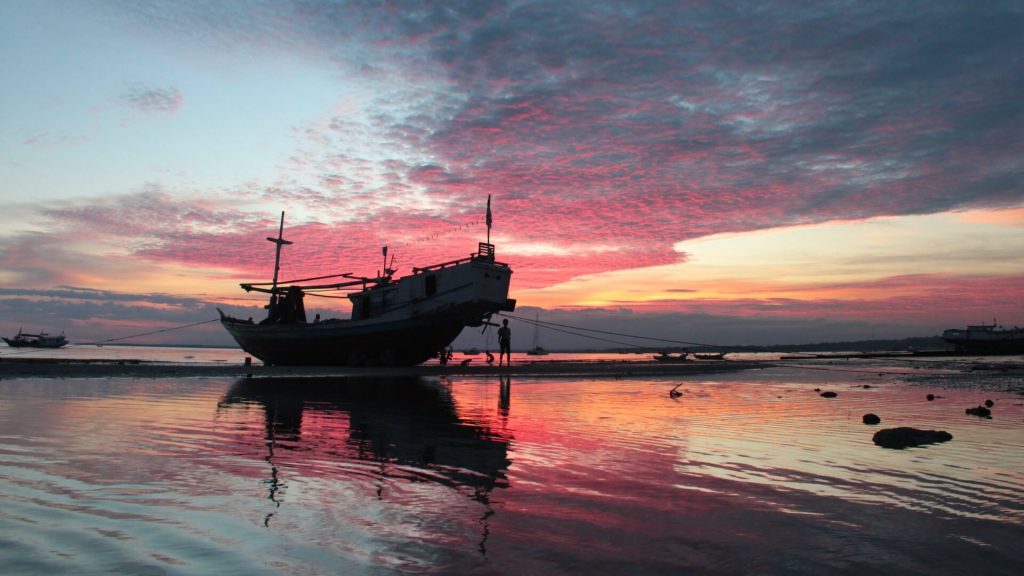Bira – Sulawesi’s Hidden Treasure
By Chris Alexander
https://www.instagram.com/kakipanjang__
Cartwheeling across the atlas like a starfish in a riptide, the island of Sulawesi billows over the Banda Sea and into the Maluccas of eastern Indonesia. At the fingertip of its southwestern arm, the small fishing village of Bira and its surrounding coastal enclaves are gaining a reputation amongst travellers the world over as a hidden gem.
For those who are willing to make the trip, this flailing sword arm of Sulawesi is at the cutting edge of adventure travel; a stepping-off point for the divers’ haven of Selayar to the south and a buccaneering voyage off the beaten track. Bira is Sulawesi’s hidden treasure, well worthy of an ‘X’ on any traveller’s map.
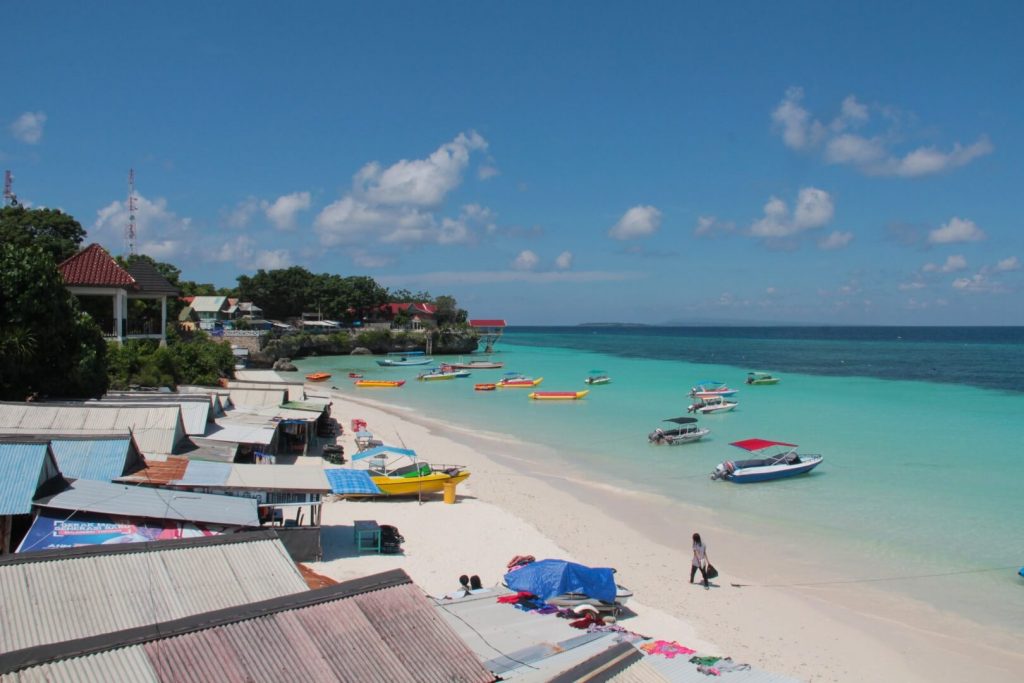
For the seafaring Bugis tribes of Bira, the ocean remains their main form of transport, haulage and employment. Ramshackle warung restaurants and huts line up in the shade of a cliff that cradles the beach – an ivory-white arch of powdery sand on the fringes of Bira. The first coffee of the day is being boiled, noodles are bubbling on a stove and clothes are drying on the corrugated rooftops. Soon, the beach will fill up with weekend tourists from Makassar, in a bloom of parasols and banana boats. But for now, Bira is its usual, drowsy weekday self, and the only footprints in the sand are the scattered etchings of seagulls. Fishing boats gently roll at anchor in the breakers, bubbling delicately up over the reef and fanning out across the shore, chasing tiny crabs back to their burrows. Further down the coast, at Bara and Tana Beru, the beaches take on a different character. At Tana Beru, teams of boat builders create traditional Phinisi vessels, using age-old techniques and a skill set passed down through the generations. Guesthouses, cafes and wooden huts line the cliff tops overlooking the beach, where hammocks swing between palm trees and shipwrecked corals are bleaching in the sun. Bara is the perfect staging point for trips to the neighbouring islands, making the area a popular spot for scuba divers.
Tana Beru is something else entirely. Here, the whine of chainsaws and a percussive tapping of hammers create an air of urgency and upheaval. Sleepy palm trees peer over the high tide line, where sawdust mingles with sand and scaffolds tower in chaotic thickets of bamboo. Clustered in piles of pick-up sticks, they encircle brooding ark-like creations taking shape within. Occasionally, a wheelbarrow whizzes up some unseen ramp in the branches, or a tool is launched overhead to waiting hands. All along the high tide line are workshops where teams of local men build the famous Phinisi boats so unique to the Bugis tribes of Southern Sulawesi. Each colossal schooner takes up to a year to build, and is put together using little more than experience, unspoken synergy between builders and a literal rule of thumb. The finished ships are sailed and sold to buyers as far afield as Canada and Russia, where private collectors, tour operators and maritime museums become the proud owners of these distinctive vessels.
All measurements are made by eye and all timbers are cut by hand. Bugis don’t make blueprints and use only the most basic of tools to build their Phinisi boats to the same design that’s existed for centuries.
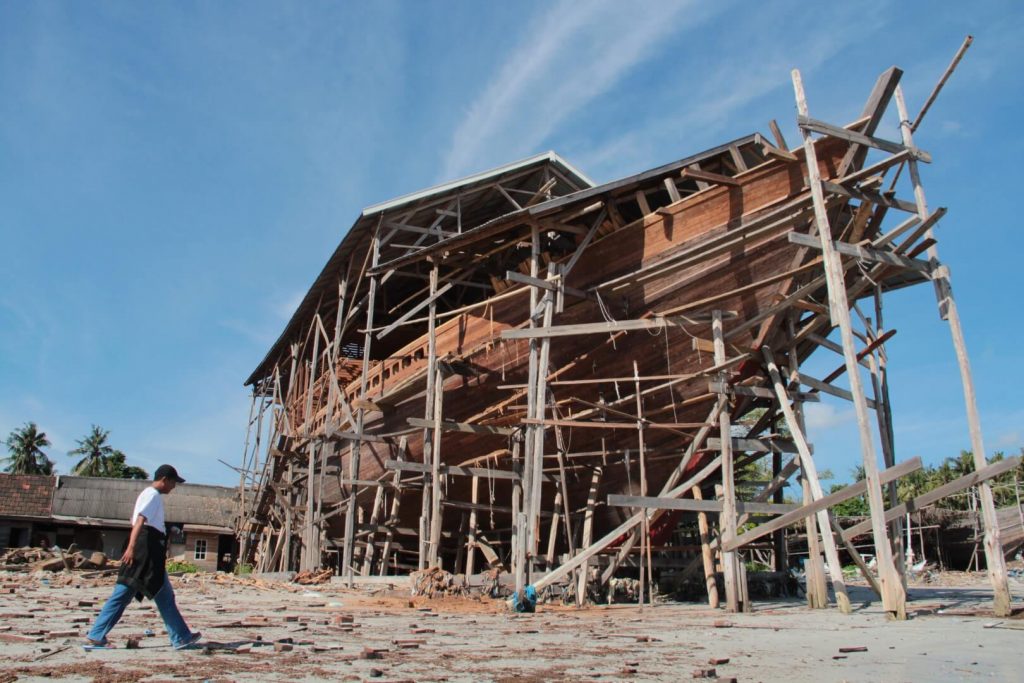
Tana Beru is a hive of activity. This is a place for sailors, chisellers, craftsmen and carpenters. Wafting up the beach is the briny perfume of the ocean and the sound of the waves bursting over the reef; a siren song for the builders of Bira, encouraging their hammers to tap that little bit faster.
As the world’s largest archipelagic nation, Indonesia is a land that’s defined by its relationship to the sea; from early days of exploration and discovery, through ages of merchant trade, travel and transportation and onto the modern stage, where Indonesia has become a popular destination for cruises and tourism; the country’s greatest successes can be attributed to its mastery of the oceans.
Skill, craftsmanship and a proud maritime tradition are all encapsulated in one iconic vessel: the Phinisi. Indonesia’s Minister of Tourism, Arief Yahya describes it as “a masterpiece in the form of a sturdy boat which emanates elegance as it spreads its seven sails.”
These distinctive ships have dominated the seas for centuries, bringing the world and all its wonders within the reach of Indonesia. Thanks to steady development of tourism in the region, with a focus on the preservation of traditional cultures and artistic heritage, Indonesia is now able to bring these superb ships to the world.
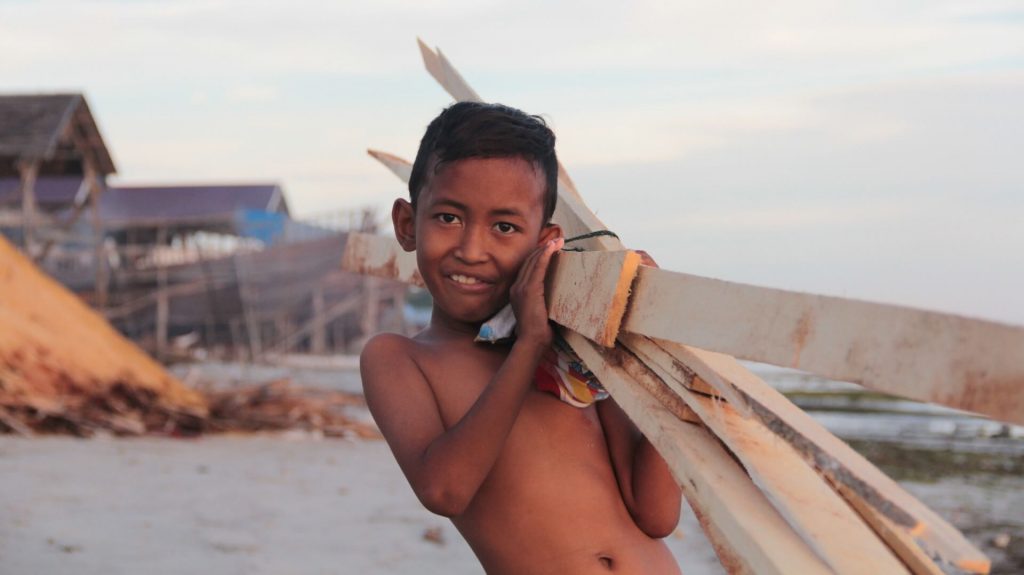
Built by the Konjo tribe, a sub-ethnic group of Bugis-Makassar from the Bulukumba regency of South Sulawesi, the Phinisi is a traditional two-masted sailing ship. Its unique design, along with its durable and dependable performance on the open ocean, make it a popular choice for local fishermen, but also for luxury cruises, sailors and collectors the world over. Keen to learn more, I set out along the coast from Bira, in search of these distinctive ships and the mysterious tribes of seafaring men who build them.
From scary bedtime stories, to golfing greens and the blue sky above, the words ‘bogey’ or ‘bogeyman’ have a special resonance in western culture. The bogeyman (or boogieman) is a phantom; an unseen but malevolent presence, waiting in the wings of our collective imagination and lurking with intent to harm or steal; bogeys in the sky are unknown aircraft, possibly hostile; whilst a bogey on the golf course is one above par – a beating of the benchmark.
But where did the word come from? Surprisingly, the answer can be found here, on this stretch of white sandy beach, fringed by coral and coconut groves on the southwestern shoreline of Sulawesi.
The spectre of Bugis sails haunted the dreams of fishermen and merchants alike. Stories of phantom pirates in the tropics soon trickled home to Europe, and the word ‘Bugis’ crept into the collective imagination of the west along with goblins, devils and ghouls; tall tales from the high seas.
The workshops at Tana Beru are busy all year round building ships to the same design that ruled the seas four hundred years ago. The Phinisi, and the Bugis who build them, remain an emblem of expert craftsmanship; a hand-made armada of pirate ships, decorating the horizon with those seven distinctive sails and broad swooping hulls, continuing to conquer the world’s oceans from the lazy coconut groves of southern Sulawesi.
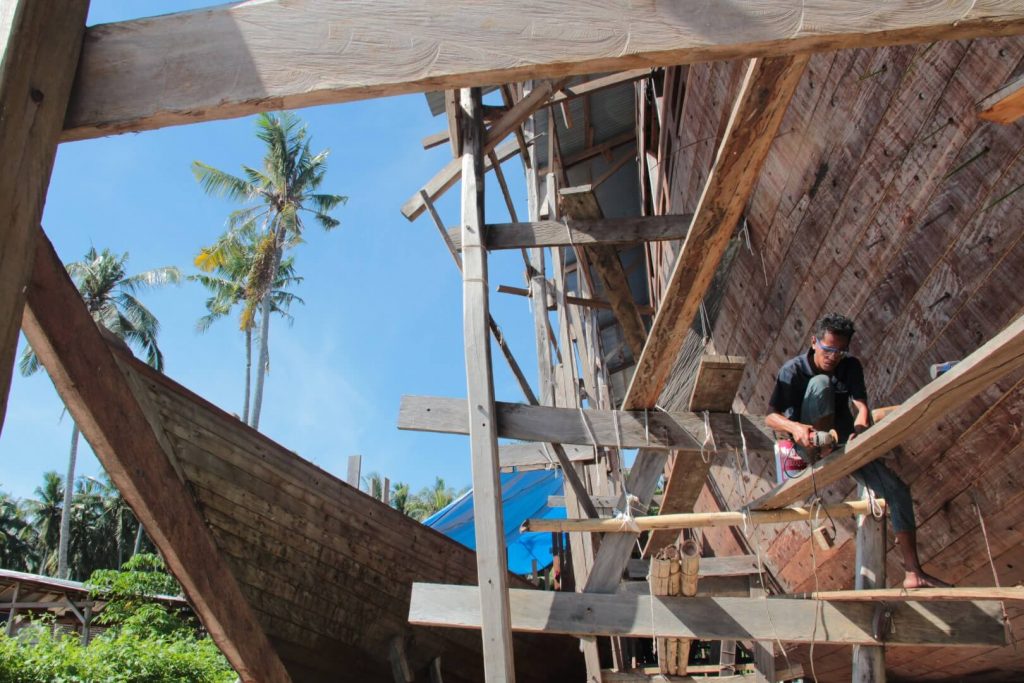
During my expedition to Tana Beru I was fortunate enough to meet many friendly Bugis, only too happy to share their stories and provide an insight into this extraordinary cultural industry. One such person was Pak Rusli Baso. Here’s what he had to say about the Phinisi and the Bugis tradition of boat building found only in Bira:
Please tell us a little about yourself
“My name is Rusli Baso. I’m 51 years old and come from Tana Beru in Sulawesi. I’ve been building the Phinisi boats here on this beach for around ten years, along with my team of three other guys. Right now, we are working on a new boat ordered by an Indonesian man in Kajang Kasi. He plans to use it for fishing.”
Can you give us some more information about the process of building a Phinisi?
“Well, a Phinisi like this one will take us around six months from start to finish. The wood is very important. We get our timbers from Central Sulawesi, because this is the only wood in the world that is durable enough and waterproof enough to make a Phinisi. Next, the wood is measured, cut and arranged into shape. One wooden beam is used to make the base. This part serves as the keel. The hull is made of wooden planks arranged outwards from the keel until the size and shape is just right.”
Where does the design come from, and how does the team cooperate?
“It’s all up here! [pointing to his head] We don’t use blueprints or instructions; everyone knows their role in the team and we make all measurements and calculations by eye. Most teams are related to each other, so we work pretty well together. Slowly, the Phinisi starts to take shape through each of us working alone, but together at the same time. It’s something we all love; seeing the shape start to emerge from nothing; it’s like a new family member being born.”
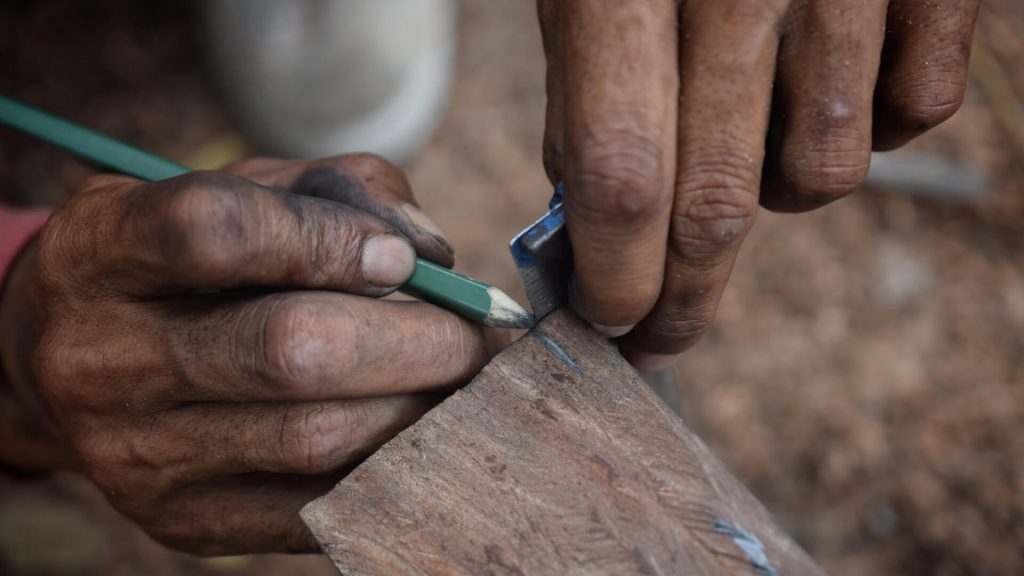
After such a labour of love, do you find it difficult to give the finished Phinisi away?
“We have a belief here that once the sails have been opened, the Phinisi belongs to the sea. You have to let it go. As Bugis, we believe that the Phinisi must not return home until it has caught a fresh load of fish or fulfilled the mission it was built for. It’s like a keris dagger; once it’s been taken out, it can’t go back until it’s tasted blood!”
Is it mostly Indonesian fishermen who buy the Phinisi?
“No, actually we make Phinisi for Europeans and Americans mostly. There’s lots of demand from cruises and private collectors. Many of the local builders here will deliver their ships personally, then work as captains for the buyer. Some take them fishing around Australia until they have caught enough fish to bring them home. Others go all around the world. Journeys like these can take about five months on the open sea.”
You said you’ve been building Phinisi for ten years. What did you do for a living before, and why did you make the change?
“I used to be a fisherman. I made the change because I am very proud of my culture and want to preserve these amazing boats for future generations. By making Phinisi, I am helping to share the unique culture of Sulawesi and the Bugis with the world.”
